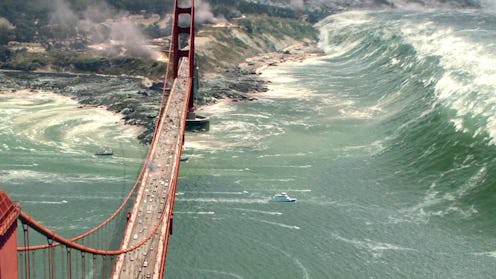News
Can A San Andreas Earthquake Cause A Tsunami?

Hollywood disaster flick San Andreas imagines what would happen to California once the long awaited massive earthquake, aka "The Big One," hits. In the movie, the Golden State splits open, buildings are leveled, the earthquake shakes the nation, and a tsunami overtakes San Francisco. None of the previously mentioned scenarios are entirely accurate, especially when it comes to whether a San Andreas earthquake can cause a tsunami.
Though seismologists have been warning of a major earthquake for years, the devastation depicted in San Andreas is a little off the mark. In addition to being a strike-slip fault, which moves plates laterally and rather minimally, the San Andreas fault primarily sits on land. For an earthquake to cause a tsunami on its own, the quake typically has to take place within the water itself and through far more volatile movement than what a strike-slip fault allows.
The possibility of the San Andreas fault triggering a tsunami on its own is highly unlikely, but there is the potential for an underwater landslide forcing one, according to San Diego State University seismologist Tom Rockwell.
Yes, it is possible. But the tsunami is not from direct displacement of ocean water by the fault, but rather because a large landslide displaces water under the ocean.
The underwater topography just under the Bay Area is a diverse landscape of peaks and valleys that, if altered by movement, could easily trigger a tsunami. Thus, if a quake were to send sediment tumbling to the sea floor, the cascade may be enough to trigger a tsunami. Likewise, there are many underwater faults just off the shores of California that pose a far larger tsunami threat than San Andreas.
One major fault line that straddles both land and sea is the Ventura fault, which scientists believe runs a far greater risk for tsunamis than previously thought. The fault cuts straight through Ventura's picturesque downtown and runs straight into the Pacific Ocean, one of the few fault lines in California that could produce the type of mega-earthquake capable of devastating the entire state. Seismologists predict a particularly strong earthquake along the fault line could produce a tsunami capable of devastating the state's central coast as well as the Santa Monica area and the rest of Southern California.
San Andreas does not address the copious fault lines throughout the Pacific Northwest, but that's probably because the movie's primary focus is, well, San Andreas. The movie does depict waters drastically receding before tsunami waves batter the Golden Gate Bridge, which is an accurate representation if, in the unlikely chance, a tsunami were to occur.
Images: Fresh Movie Trailers/Youtube, Getty Images (1)